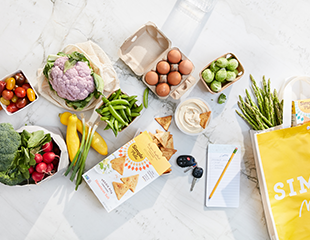Whether you grocery shop once a week or once a month, set yourself up for success with a few simple strategies that will give you confidence behind the shopping cart.
#1 Make a Menu

Before heading to the grocery store, create a menu for the week or month. Pick a few basic food combinations to make multiple meals and select a few recipes to guide you as you whip up original culinary creations. Plan meals and snacks in a weekly format just like a calendar. This can be helpful in identifying meal gaps and when certain pantry staples may run out. Strategically planning meals, snacks and desserts can help properly portion out meals and prevent food waste, but if you find yourself with extra food scraps, get creative and repurpose them. Any leftovers from meals can be frozen for later enjoyment.
#2 Pick Plant-Forward Options

Your grocery haul should reflect the plate, meals and life you are trying to create, so if you intend to focus on a plant-forward lifestyle, fill your grocery cart with leafy greens to support fiber and phytonutrient intake. This means your grocery cart should be at least half full of fresh produce and plant-based options. When choosing fresh fruits and vegetables, choose a variety of foods and shop for all of the colors of the rainbow.
#3 Plan Balanced Snacks

Meal planning for breakfast, lunch and dinner is important, but don’t forget snacks. When forgetting to plan for snacks, you may end up choosing mindless food options that aren’t satisfying or satiating. Instead, choose mindful snacks that include well balanced proportions of fat, fiber and protein. Some simple snack options that are great go-tos are almond flour crackers, beans, fresh produce paired with a nut or seed butter, legumes, nuts, seeds and soft baked bars.
#4 Read Ingredient Labels Before the Nutrition Facts

Ingredients are the most important factor when deciding whether or not to invest in a food product. When grocery shopping, choose foods with ingredients you can pronounce and recognize. Chances are if you can recognize a whole food ingredient, your body will be able to recognize it. After examining the list of ingredients, check the grams of fiber, protein and sugar. If sugar is included in your food product, look for natural sugar options and stick to foods with less than 7 grams of sugar.
Tip: Looking for more tips on what to look for when reading an ingredient label? Here’s everything you need to know about ingredient labels.
Grocery shopping doesn’t have to be mindless, instead, make it mindful by practicing these four tips the next time you shop for your weekly or monthly grocery haul. Happy grocery shopping!
Tag us @SimpleMills and show us your mindful grocery haul complete with your favorite Simple Mills staples.